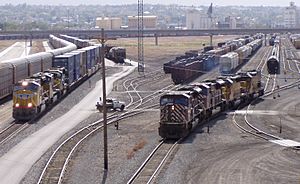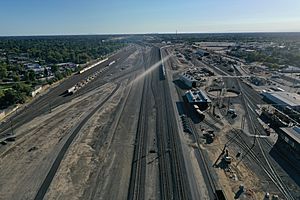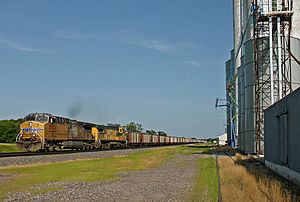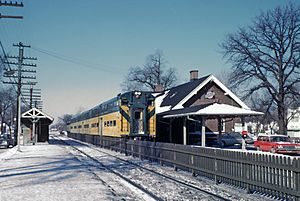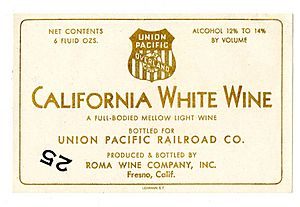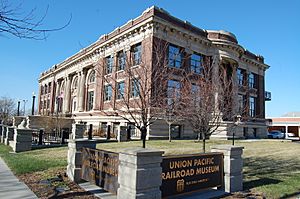Union Pacific Railroad facts for kids
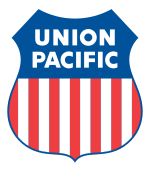 |
|
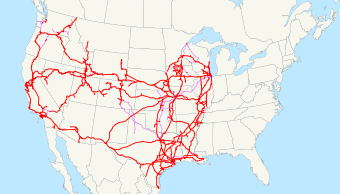
System map (trackage rights in purple)
|
|
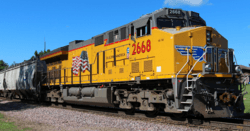
UP 2668, a GE ET44AH, photographed in June 2016
|
|
| Overview | |
|---|---|
| Parent company | Union Pacific Corporation |
| Headquarters | Union Pacific Center at 1400 Douglas Street, Omaha, Nebraska |
| Reporting mark | UP (road locomotives), UPP (passenger cars), UPY (yard locomotives) |
| Locale | Western, Midwestern and Southern United States |
| Dates of operation | 1862–present
|
| Technical | |
| Track gauge | 4 ft 8 1⁄2 in (1,435 mm) standard gauge |
| Length | 32,100 miles (51,700 km) |
The Union Pacific Railroad (reporting marks UP, UPP, UPY), legally Union Pacific Railroad Company and often called simply Union Pacific, is a freight-hauling railroad that operates 8,300 locomotives over 32,200 miles (51,800 km) routes in 23 U.S. states west of Chicago and New Orleans. Union Pacific is the second largest railroad in the United States after BNSF, with which it shares a duopoly on transcontinental freight rail lines in the Western, Midwestern and West South Central United States.
Founded in 1862, the original Union Pacific Rail Road was part of the first transcontinental railroad project, later known as the Overland Route. Over the next century, UP absorbed the Missouri Pacific Railroad, the Western Pacific Railroad, the Missouri–Kansas–Texas Railroad and the Chicago, Rock Island and Pacific Railroad. In 1995, the Union Pacific merged with Chicago and North Western Transportation Company, completing its reach into the Upper Midwest. In 1996, the company merged with Southern Pacific Transportation Company, itself a giant system that was absorbed by the Denver and Rio Grande Western Railroad. The Union Pacific Railroad is the principal operating company of the Union Pacific Corporation, which are both headquartered at the Union Pacific Center, in Omaha, Nebraska.
Contents
History
Union Pacific in the 19th century
The original company, the "Union Pacific Rail Road", incorporated on July 1, 1862, under the Pacific Railroad Act of 1862. President Abraham Lincoln had approved the act, which authorized railroad construction from the Missouri River to the Pacific to ensure the stability of the Union throughout the American Civil War, but construction did not complete until after that conflict's conclusion. The resulting track ran westward from Council Bluffs, Iowa to meet in Utah the Central Pacific Railroad line, which had been constructed eastward from Sacramento, California. The combined Union Pacific–Central Pacific line became known as the First transcontinental railroad and later the Overland Route.
The line was constructed primarily by Irish labor who had learned their craft during the recent Civil War. Under the guidance of its dominant stockholder Dr. Thomas Clark Durant, the namesake of the city of Durant, Iowa, the first rails were laid in Omaha. The two lines were joined at Promontory Summit, Utah, 53 miles (85 km) west of Ogden on May 10, 1869, hence creating the first transcontinental railroad in North America.
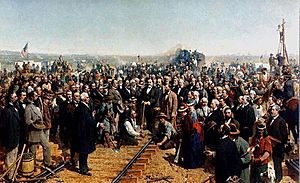
Subsequently, the UP purchased three Mormon-built roads: the Utah Central Railroad extending south from Ogden to Salt Lake City, the Utah Southern Railroad extending south from Salt Lake City into the Utah Valley, and the Utah Northern Railroad extending north from Ogden into Idaho.
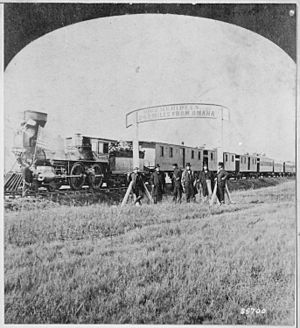
The original UP was entangled in the Crédit Mobilier scandal, exposed in 1872. As detailed by the New York Sun, Union Pacific's largest construction company, Crédit Mobilier, had overcharged Union Pacific; the railroad would then pass the inflated costs on to the United States government. To convince the federal government to accept the increased costs, Crédit Mobilier had bribed multiple congressmen. Several prominent UP board members (including Durant) had been involved in the scheme. The ensuing financial crisis of 1873 led to a credit crunch, but not bankruptcy.
As boom followed bust, the Union Pacific continued to expand. A new company, with dominant stockholder Jay Gould, purchased the old on January 24, 1880. Gould already owned the Kansas Pacific (originally called the Union Pacific, Eastern Division, though in essence a separate railroad), and sought to merge it with UP. Through that merger, the original "Union Pacific Rail Road" transformed into "Union Pacific Railway".
Extending towards the Pacific Northwest, Union Pacific built or purchased local lines to reach Portland, Oregon. Towards Colorado, it built the Union Pacific, Denver and Gulf Railway: a system combining narrow-gauge trackage into the heart of the Rockies and a standard gauge line that ran south from Denver, across New Mexico, and into Texas.
The Union Pacific Railway would later declare bankruptcy during the Panic of 1893. The resulting corporate reorganization reversed Gould's name change: Union Pacific "Railway" merged into a new Union Pacific "Railroad".
Union Pacific in the 20th century
In the early 20th century, Union Pacific's focus shifted from expansion to internal improvement. Recognizing that farmers in the Central and Salinas Valleys of California grew produce far in excess of local markets, Union Pacific worked with its rival Southern Pacific to develop a spoilage-resistant rail-based transport system. These efforts came culminated in the 1906 founding of Pacific Fruit Express, soon to be the world's largest lessee of refrigerated railcars.
Meanwhile, Union Pacific worked to construct a faster, and more direct substitute for the original climb to Promontory Summit. In 1904, the Lucin cutoff opened, reducing curvature and grades. The original route would eventually be stripped of track in 1942 to provide war scrap.
To attract customers during the Great Depression, Union Pacific's chairman W. Averell Harriman simultaneously sought to "spruce up" the quality of its rolling stock and to make its unique locations more desirable travel destinations. The first effort resulted in the purchase of the first streamlined train: the M-10000. The latter resulted in the Sun Valley ski resort in central Idaho; it opened in 1936 and finally was sold in 1964. Despite the fact that the M-10000 and its successors were among the first diesel locomotives, Union Pacific completed dieselization relatively late. In 1944, UP finally received delivery of its last steam locomotive: Union Pacific 844.
As the 20th century waned, Union Pacific recognized—like most railroads—that remaining a regional railroad would only lead to bankruptcy. On December 31, 1925, UP and its subsidiaries operated 9,834 miles (15,826 km) routes and 15,265 miles (24,567 km) tracks; in 1980, these numbers had remained roughly constant (9,266 route-miles and 15,647 track-miles). But in 1982, UP acquired the Missouri Pacific and Western Pacific railroads, and 1988, the Missouri–Kansas–Texas. By 1993, Union Pacific had doubled its system to 17,385 miles (27,978 km) routes.
By then, few large (class I) railroads remained. The same year that Union Pacific merged with the Chicago and North Western (1995), Burlington Northern and ATSF announced merger plans. The impending BNSF amalgamation would leave one mega-railroad in control of the west. To compete, UP merged with Southern Pacific, thereby incorporating D&RGW and Cotton Belt, and forming a duopoly in the West. The merged railroad took the Union Pacific name.
| Year | Traffic |
|---|---|
| 1925 | 1,065 |
| 1933 | 436 |
| 1944 | 5,481 |
| 1960 | 1,233 |
| 1970 | 333 |
Facilities
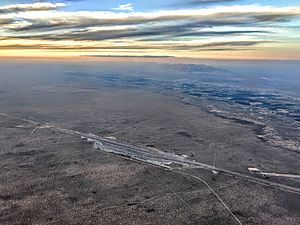
The Union Pacific system includes hundreds of yards. Most are flat yards used for local switching. Other types of yards include intermodal terminals and hump yards. Most UP intermodal terminals are typically ports, but UP also has inland terminals for transfers to trucks, such as the terminal in San Antonio that opened in 2009 or the one in Santa Teresa, New Mexico, that opened in 2014.
Hump yards
In 2006, Union Pacific had 11 major active hump yards:
- Bailey Yard in North Platte, Nebraska
- Beaumont Yard in Beaumont, Texas
- Davidson Yard in Fort Worth, Texas
- Davis Yard in Roseville, California
- Englewood Yard in Houston, Texas
- Gateway Yard in East St Louis, Illinois, owned by subsidiary Alton and Southern Railway
- Livonia Yard in Livonia, Louisiana
- North Little Rock Yard in North Little Rock, Arkansas
- Proviso Yard in Northlake, Illinois, owned by Chicago and North Western Transportation Company until 1995
- Strang Yard in La Porte, Texas
- West Colton Yard in Bloomington, California
In the late 2010s, Union Pacific began deactivating hump yards in favor of flat switching. In this, Union Pacific followed the industry-wide trend towards Precision Scheduled Railroading (PSR); railway executive Hunter Harrison explained that under PSR, few yards receive enough variegated traffic to necessitate a hump. Union Pacific also closed facilities in Kansas City ("Neff yard"), Hinkle, Oregon, and Pine Bluff, Arkansas in 2019.
Facts and figures
According to UP's 2007 Annual Report to Investors, at the end of 2007 it had more than 50,000 employees, 8,721 locomotives, and 94,284 freight cars.
Broken down by specific type of car, owned and leased:
- 35,437 covered hoppers
- 12,272 boxcars
- 18,647 open-top hoppers
- 13,780 gondolas
- 14,148 "other" types of cars
In addition, it owns 6,950 different pieces of maintenance of way work equipment. At the end of 2007, the average age of UP's locomotive fleet was 14.8 years, the freight car fleet 28 years.
UP was ranked 134th on the 2019 Fortune 500 list of the largest United States corporations by revenue and had 41,967 employees. The president of Union Pacific since 2015 is Lance Fritz.
Union Pacific has been rated the worst company to work for in 2019 by 247wallst.com, citing CEO Lance Fritz's 12% approval rating and the 22% recommendation rating from Glassdoor.com.
Passenger service
Commuter services
When Union Pacific bought out the Chicago & North Western in 1995, it inherited the railroad's Metra commuter rail services in the Chicago metropolitan area: the UP/North, UP/Northwest, and UP/West lines, all of which operate from the Ogilvie Transportation Center (the former North Western Station–a name still used by many Chicago residents). In order to ensure uniformity across the Chicago area commuter rail system, trains are branded as Metra services and use Metra equipment. However, Union Pacific crews continue to operate the trains under a purchase-of-service agreement.
Former services
Between 1869 and 1971, Union Pacific operated passenger service throughout its historic "Overland Route". These trains ran between Chicago and Omaha on the Chicago & Northwestern trackage starting in 1936. Disputes over trackage rights and passenger revenues with the C&NW prompted the UP to switch to the Milwaukee Road for the handling of its streamliner trains between Chicago and Omaha beginning in late 1955. The last intercity passenger train operated by UP was the westbound City of Los Angeles, arriving at LA Union Station on May 2. Since then, Union Pacific has satisfied its common carrier requirements by hosting Amtrak trains.
Hosted trains
Many Amtrak and commuter rail routes use Union Pacific rails. This list excludes the commuter services the company directly operates in Chicago.
Environmental record
In Eugene, Oregon, where pollution from a century-old rail yard has been seeping into groundwater, the UP and the Oregon Department of Environmental Quality launched a study of ground contamination in 2008. The pollutants are mostly petroleum hydrocarbons, industrial solvents, and metals.
In 2007, Union Pacific Railroad worked with the US EPA to develop a way to reduce locomotive exhaust emissions. They discovered that adding an oxidation catalyst filtering canister to the diesel engine's exhaust manifold and using ultra-low-sulfur diesel fuel would reduce particulate emissions by about half, unburned hydrocarbons by 38 percent, and carbon monoxide by 82 percent.
The company's Fuel Master program rewards locomotive engineers who save the most fuel each month. The program has saved the company millions of dollars, much of which has been returned to the engineers. In 2006, the program's founder, Wayne Kennedy, received the John H. Chafee Environmental Award, and the program was recognized by Transportation Secretary Norman Mineta.
In January 2018, a former waste water operator at Union Pacific Albina Yard in Portland, Oregon, employed by the railroad's contractor Mott MacDonald negligently released thousands of gallons of oil into the environment. The operator was distracted by a cell phone and allowed the tank to overflow for over an hour. An engineering firm hired by Union Pacific estimates 1,800 U.S. gallons (6,800 liters) of it was released into nearby Willamette River, not including the spill that was captured by the containment booms. Employees of United States Environmental Protection Agency who were working at facilities nearby placed booms to contain the oil spill. Federal prosecutors have charged the operator Robert LaRue Webb II with violation of the Clean Water Act for releasing the oil into the environment. Webb plead guilty in August 2019 and was sentenced to two years probation and a $2,500 fine.
In 2016, the Union Pacific Railroad Co. was named as a defendant in a lawsuit seeking cleanup of a contaminated rail yard site that operated in Lafayette, Louisiana, from the late 1800s until the 1960s.
In 2020, Houston residents living near a Union Pacific Railroad Company rail yard filed lawsuits against the Union Pacific. These lawsuits followed the finding by the State of Texas of a higher-than-expected incidence of certain cancers in residents living close to the yard. A State of Texas report released in 2021 identified an additional cancer cluster of lymphoblastic leukemia in children.
EMP
Union Pacific and Norfolk Southern are the largest owner-partners of Equipment Management Pool (EMP), a domestic freight interline intermodal freight transport service that rents and moves more than 35,000 53-foot containers and chassis throughout North America. Other partners in the freight company include CN Railway, CP Railway, I&M Rail Link, Iowa Interstate Railroad, Wisconsin Central Ltd., and Kansas City Southern Railway.
Union Pacific Railroad Museum
The Union Pacific Railroad Museum is a former Carnegie library in Council Bluffs, Iowa, that houses artifacts, photographs, and documents that trace the development of the railroad and the American West. The company pays upkeep on the privately owned building, which houses part of Union Pacific's corporate collection, one of the oldest in the United States. Holdings include weapons from the late 19th and 20th centuries, outlaw paraphernalia, a sampling of the immigrants' possessions, and a photograph collection comprising more than 500,000 images.
Images for kids
-
UP locomotive GE AC4400CW #5645 in Battle Creek, Michigan, with the Flags and Flares paint scheme
-
Union Pacific #5391, approaching bridge at Multnomah Falls, Oregon, shows the white-outlined blue "wings" on the nose.
-
Union Pacific #6419, in Checotah, Oklahoma, with the Flags and Flares paint scheme leads a train on June 26, 2021
See also
 In Spanish: Union Pacific para niños
In Spanish: Union Pacific para niños
- Central Pacific Railroad
- First transcontinental railroad
- Hell on Wheels (TV series involving Union Pacific set in 1865)
- History of rail transportation in California
- Kansas Pacific Railway
- Los Angeles and Salt Lake Railroad
- Missouri–Kansas–Texas Railroad
- Missouri Pacific Railroad
- Oregon Railroad and Navigation Company
- Oregon Short Line
- Pacific Fruit Express
- Railex
- Southern Pacific Transportation Company
- Sun Valley, Idaho
- Western Pacific Railroad


